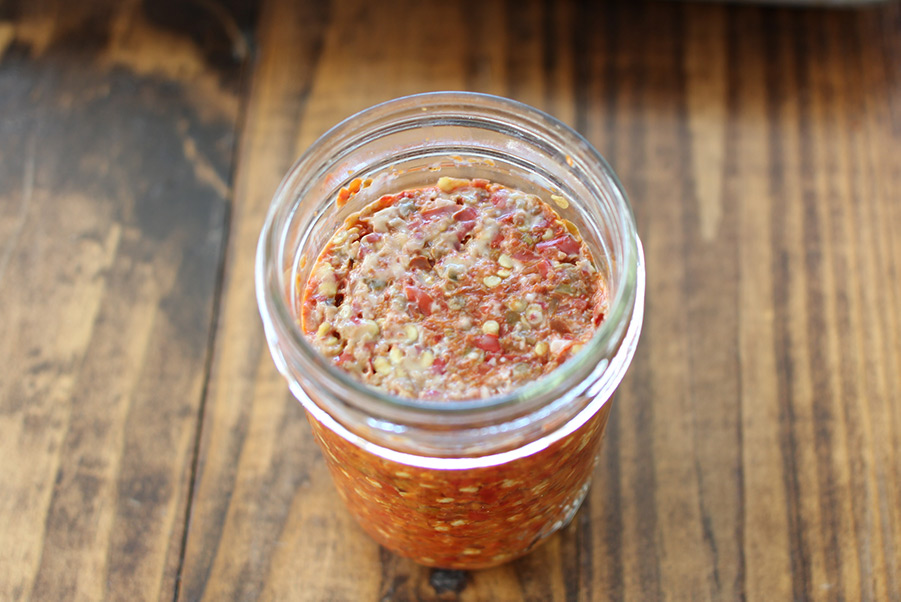
Have your ferments been getting moldy or developing a white film on the surface lately? Do they seem to be lacking that zingy flavor or getting mushy and soft? If so, it might be the warm temperatures. These issues may be avoided if you follow my tips for fermenting in hot weather.
Hello Summer! It’s getting hot, hot, hot. Summer is my favorite time of year. My most precious memories have taken place in the Summer.
It conjures up memories of camping on the lake with my family, boogie boarding, night swims, eating Cheez-its, egg sandwiches and Grape Safeway Select soda. The only time my mom would let us eat “junk food” was when we went camping. She would also buy those Danish breakfast pastries from Costco. Camping with my family and Summer was the best.
I love Summer, but my ferments don’t.
During the Winter ferments almost come to a standstill. It can get too cold for them to activate and ferment. The Summer heat does the opposite.
As a result of the Summer heat, they can get too active and ferment too fast causing all kinds of problems.
Most ferments do best in temperatures of about 68 – 80 degrees fahrenheit. They can ferment too slow and take too long if they’re below that temperature range and if above they ferment too fast, develop mold and lack flavor.
Here are some of the common issues with fermenting in hot weather
Mold
Mold loves moisture and heat. Mold can develop on the surface of your pickles or sauerkraut if it’s too hot. The moisture in the jar caused by the increased temperature is the perfect recipe for mold. I’ve had mold on the surface of my pickles and sauerkraut the most in Summer.
If mold develops on the surface you can scrape it off. Everything under the brine is fine. If you know you’re sensitive to mold or it grosses you out too much then throw it out.
Also see my post, “How To Prevent Mold When Fermenting Vegetables” if you’re consistently having mold issues.

Kahm Yeast
Kahm yeast is a white, milky substance that can grow on the surface of ferments. Many times people mistake it for mold. Kahm yeast seems to show up often on the surface of my pickles and sauerkraut in the Summer. Especially my cucumber pickles and hot pepper mashes.
It smells funky and looks weird, but it’s totally harmless. Kahm yeast is a common wild yeast and is safe. Scrape it off the surface when you’re ready to store the ferment in the fridge. Otherwise it will show up again and you’ll be scraping it off daily.
Also see my post, “What Is That White, Milky Stuff On My Fermented Veggies” for more on kahm yeast.

Soft & mushy pickles
Hot temperatures make the bacteria very active. The increased activity causes your pickles, fermented veggies and sauerkraut to ferment faster. Which can cause them to get soft and mushy. There’s nothing worse than biting into a mushy, soggy pickle. So, if you’re pickles have been turning out mushy and soft and it’s been hot in your house, that’s probably why.
Your ferments are lacking flavor
I mentioned previously that hot temps cause the bacteria to become very active which causes your pickles or sauerkraut to ferment faster. When they ferment faster they don’t develop as much flavor as a slow ferment. You might notice that your pickles and sauerkraut taste better when fermented during cooler temperatures like in the Spring or late Fall.
Slimy sauerkraut
If you noticed that your sauerkraut has a slimy texture, it could be hot temperatures. Slimy sauerkraut is gross. If this happens let it ferment longer to see if it goes away. Sometimes it does. If it doesn’t I would toss it out.
Tips For Fermenting In Hot Weather
If you’re not getting good results with your ferments and it’s been hot in your house, follow these tips for fermenting in hot weather.
1. Place ferments in a cool part of your house
If there’s a room in your house that stays cooler than the kitchen, then place them there. Try the basement, a low cabinet, near an air conditioner or fan.
2. Place them in a cooler
Place your ferments in an empty cooler to keep the temperature regulated. If the cooler is still too hot, you can place an ice pack with them to keep it cooler inside. Don’t place an ice pack on the ferments or they won’t ferment at all. Near them in a cooler will work great though.
3. Ferment for less time
Since the higher temperatures cause the bacteria to be more active then ferment them for less time. Recipes that call for 7 days normally may be ready in 5 days. Check them often to see if they’re ready. I check my pickles after 3 days in the Summer to get an idea of how long they’ll take. I usually only ferment them for 5 days max in hot temps.
4. Taste them more often
Get in the habit of checking on your ferments more often in the Summer. Check the texture after 3 days, smell them and taste them too. Check every two days to see if they’re ready. I’ve had ferments that went from not ready to fermented after one day. So check them often.
Have you noticed changes to your ferments during the Summer or have any tips you’d like to share? Leave a comment below.
Happy Fermenting!
Danielle